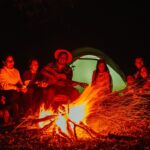From Espresso to Chili: The Versatile Camp Stoves You Need for Your Next Hike

When it comes to backpacking, having a reliable and versatile camping stove is a must. Whether you want to make an espresso in the morning, cook a quick lunch or stew up a hearty chilli for dinner, the right camping stove can make all the difference.
In this blog post, we’ll explore the best backpacking cookers that can meet a variety of cooking needs, from the smallest single burner models to more powerful group dining setups.
We’ll highlight key features, pros and cons and provide tips on how to choose the right cooker for your next hike.
So whether you’re a seasoned backpacker or a novice, read on to learn about the most versatile camping stoves you’ll need for your next adventure.
A dependable and versatile camp stove is essential equipment for any backpacker seeking a successful and enjoyable outdoor experience.
A good stove provides a consistent source of heat for cooking hot meals and drinks, which is essential for staying hydrated and maintaining energy levels on the trail.
It is critical to select a stove that is dependable and safe, regardless of the weather or altitude.
Furthermore, choosing a versatile stove capable of cooking a wide range of dishes, from simple soups to more complex meals such as chili or stir-fry, can help improve your camping experience.
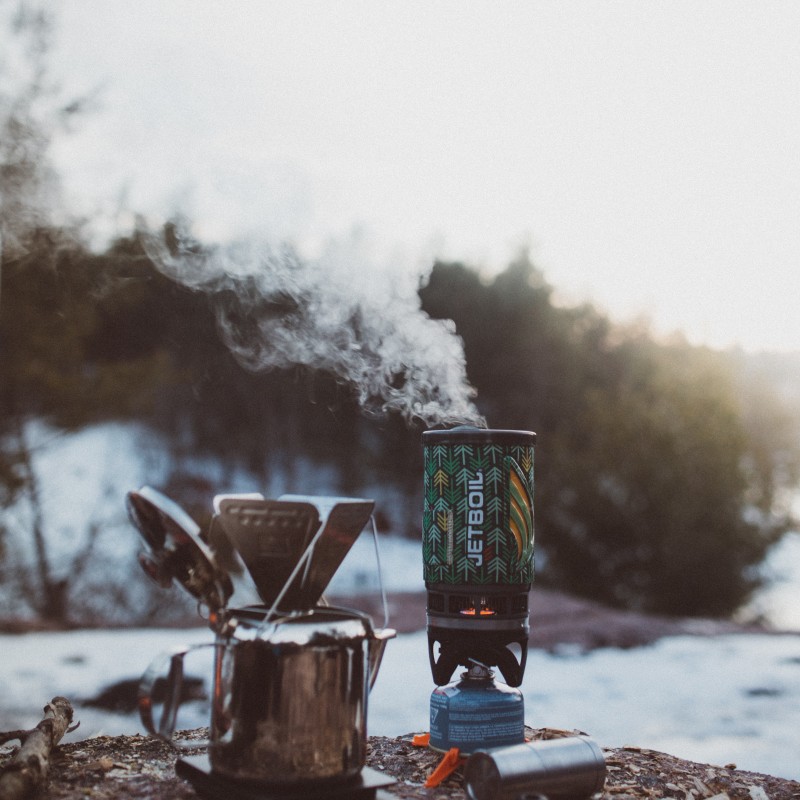
A dependable and versatile stove can also save you time and effort by allowing you to cook quickly and efficiently, allowing you to spend more time exploring your surroundings or relaxing at camp.
Furthermore, having a good camp stove can help you reduce waste because you can cook exactly what you need, minimizing leftovers and lowering your environmental impact.
In conclusion, investing in a dependable and versatile camp stove is a must for anyone who wants to enjoy their outdoor adventure while also enjoying delicious, hot meals.
This post is a detailed guide to selecting the best backpacking camp stove. The post discusses the importance of having a dependable and versatile stove when backpacking, as well as the features to look for when choosing the right stove.
The post also includes reviews of some of the best backpacking stoves available, such as the MSR PocketRocket 2, Jetboil Flash, and BioLite CampStove 2.
Each stove is thoroughly reviewed, emphasizing its features, benefits, and drawbacks to assist readers in making an informed decision when purchasing a stove.
This blog also discusses how to use and maintain the camping stove to ensure the best performance and service life.
Whether you are a first-time backpacker or an experienced adventurer, this article will teach you how to choose the best camping stove for your next backpacking trip.
Fuel Types
Choosing the right fuel type for your stove is an important consideration for any outdoor adventure.
Propane is easy to find and use, while butane is more compact and better for shorter trips.
White gas burns hotter and is ideal for cold temperatures, but kerosene is more readily available worldwide.
Consider your trip length, weather conditions, and availability when choosing your fuel type.
Comparison of different fuel types (propane, butane, white gas, kerosene)
When choosing a camping stove for backpacking, it is important to consider the type of fuel it uses. There are several fuels to choose from including propane, butane, white gas and paraffin.
Propane and butane are popular choices because they are easy to find, burn cleanly and fit easily in small canisters. However, they can be bulky and heavy and their performance can be affected by low temperatures.
White gas and paraffin are more versatile fuel choices and work well in cold temperatures and at high altitudes.
They are lighter and more compact than propane and butane, making them a popular choice for long backpacking trips.
However, they require more maintenance and can be messy to use. Ultimately, the choice of fuel type depends on your needs and preferences.
Factors such as weight, portability, ease of use and performance in different weather conditions should be considered when choosing a cooker and fuel type for a backpacking trip.
Considerations for choosing a stove based on fuel type
When selecting a camp stove for backpacking, it’s crucial to consider the fuel type you plan to use. Different fuel types have unique characteristics that can affect a stove’s performance, so it’s essential to choose a stove that matches your preferred fuel type.
For example, if you plan to use propane or butane, you’ll want a stove designed to work with those specific fuels. These fuels are clean-burning and readily available, but their performance can suffer in cold temperatures.
On the other hand, stoves that work with white gas or kerosene are more versatile and perform well in cold temperatures, making them an excellent choice for winter backpacking trips.
However, these fuels require more maintenance, and the stoves can be messier to use.
Ultimately, the choice of fuel type depends on your needs and preferences, so consider factors such as weight, portability, ease of use, and performance in different weather conditions when selecting a stove and fuel type for your backpacking trip.
Size and Weight
When backpacking, every ounce and cubic inch counts, making a lightweight and compact stove a crucial gear choice.
Look for stoves with aluminum or titanium construction and minimal features. Consider the pot size and fuel efficiency for your trip length and group size.
Compact stoves save space in your pack and reduce overall weight.
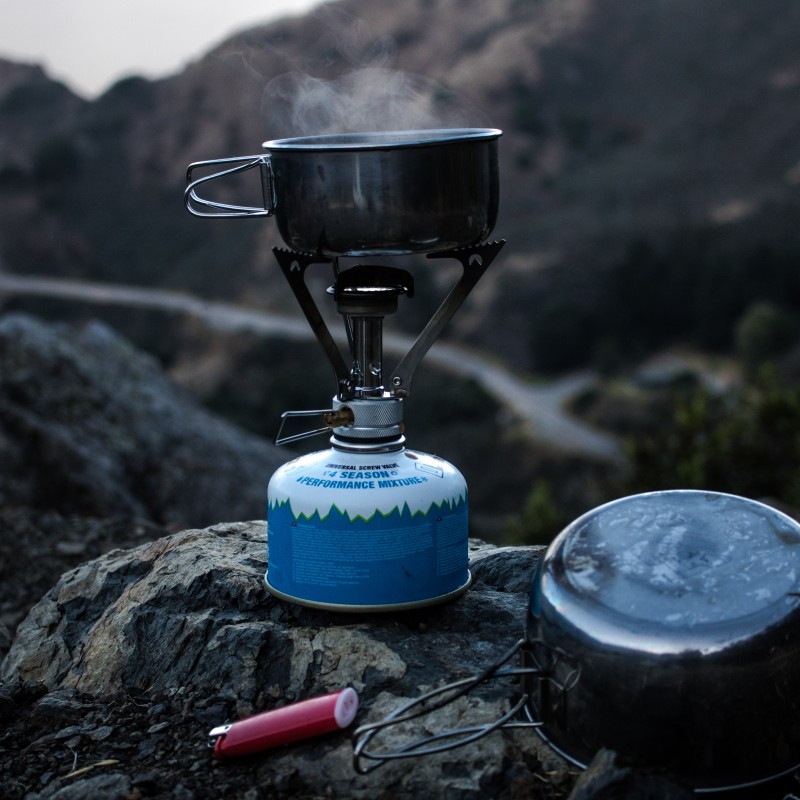
Importance of choosing a lightweight and compact stove for backpacking
Choosing a lightweight and compact cooker is vital for backpacking as it will significantly affect the overall weight of your gear and the amount of space your pack takes up.
Every ounce counts when traveling long distances, so choosing a lightweight cooker can help reduce the overall weight of your pack.
In addition, compact cookers take up less space, leaving more room for other essential equipment such as food, water and shelter.
A small stove is also easier to pack and transport, especially when trekking. However, it is important to strike a balance between weight, size and performance.
You don’t want to sacrifice the functionality or durability of your cooker to save a few ounces or inches of space.
Ultimately, the right cooker for you will depend on your specific needs, the length of your trip, and the conditions you expect to encounter.
Considerations for choosing a stove based on size and weight
When choosing a camp stove for backpacking, the size and weight of the stove are essential factors to consider.
A lightweight and compact stove can reduce the overall weight of your pack and take up less space, leaving room for other essential gear.
However, a stove that’s too small or light may sacrifice functionality or durability, making it challenging to use in adverse weather conditions.
On the other hand, a larger and more robust stove may offer better performance but can be bulky and heavy to carry, adding unnecessary weight to your pack.
It’s essential to strike a balance between size, weight, and performance to choose a stove that meets your needs without compromising on functionality or durability.
Additionally, consider the length of your trip and the conditions you expect to encounter when selecting a stove’s size and weight. A longer trip or harsher weather conditions may require a more robust and reliable stove.
Features and Functionality
Stove features can enhance your cooking experience and improve the longevity of your gear. Look for stoves with ignition systems, simmer controls, and easy-to-clean designs.
Consider the types of meals you plan to prepare and the level of maintenance required. Features like wind protection and pot supports also impact functionality in the field.
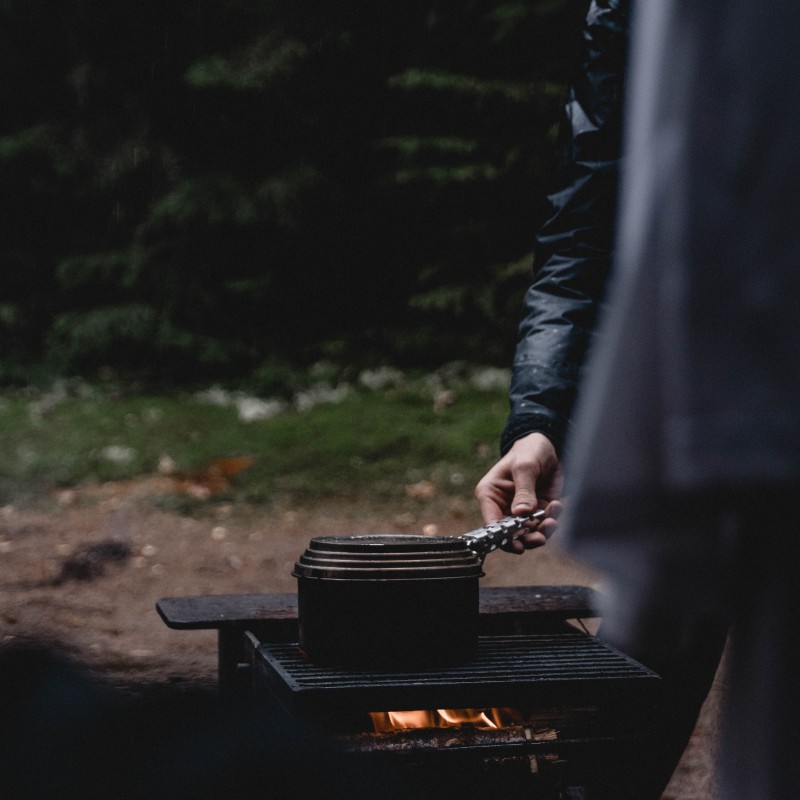
Common stove features (ignition, simmer control, cleaning and maintenance)
When selecting a camp stove for backpacking, it’s important to choose a model that has the features you need to cook efficiently and comfortably.
Common stove features include ignition systems, simmer control, and cleaning and maintenance ease.
An integrated ignition system eliminates the need for matches or a lighter, while simmer control allows you to adjust the heat output to maintain a constant temperature.
Cleaning and maintenance are crucial for ensuring the stove works safely and efficiently. Some stoves have removable components for easy cleaning, while others require disassembly.
It’s important to consider the features you need without adding unnecessary weight or complexity. Your cooking style, trip length, and expected weather conditions should guide your choice of the stove with the right features for your backpacking needs.
Considerations for choosing a stove based on features and functionality
When choosing a backpacking stove, think about the features and functionality that will best suit your needs.
The type of fuel is an important consideration because each has its own set of advantages and disadvantages.
The size and weight of the stove are also important considerations to ensure that it is portable and easy to transport on your backpacking trip.
Other important considerations include ignition, simmer control, and cleaning and maintenance. It’s critical to strike a balance between the features you require and the weight and complexity of the stove.
Your cooking style, trip length, and expected weather conditions should all be considered when selecting a stove with the right features and functionality for your backpacking needs.
Single-Burner Stoves
This review contains information about single-burner stoves if you’re shopping for one. We examined the best choices, highlighting their salient traits, advantages and disadvantages, and general effectiveness.
These stoves give outdoor cooks a lot, from mobility to fuel economy, and adjustable flame control to dependable ignition mechanisms.
Review of top single-burner stoves
Because of their small size and lightweight, single-burner stoves are a popular choice for backpackers. When selecting a single-burner stove for your backpacking trip, make sure it’s dependable, efficient, and simple to use.
This review will look at the best single-burner stoves on the market, evaluating their performance, fuel efficiency, and overall value.
Each stove will be compared based on its distinct features, such as weight, ignition, simmer control, and maintenance requirements.
Ease of use and portability will also be considered. By the end of this review, you’ll have a better idea of which single-burner stove is best for your backpacking needs.
Key features, pros and cons, overall performance
When evaluating backpacking cookers, it is critical to consider their key features, benefits and drawbacks, and overall performance.
Size, weight, fuel type, ignition, vent control, and ease of cleaning and maintenance are all important features of the cooker. Fuel efficiency, boiling time, wind resistance, and overall durability should all be considered.
The overall performance of a cooker should be judged by how well it performs in actual backpacking conditions, such as different altitudes, temperatures, and weather conditions.
By considering these factors, you can get a better idea of which cooker is the best choice for your needs. For example, a lightweight cooker with a compact design and efficient fuel consumption may be the best choice for long backpacking trips.
Or, for more complex cooking requirements, a stove with powerful simmer controls may be required. Overall, it is vital to carefully assess the features, pros and cons and performance of your cooker to ensure you choose the right one for your backpacking needs.
Multi-Burner Stoves
Single-burner stoves are a popular choice for solo backpackers or small groups. Top options include the MSR PocketRocket 2, Jetboil Flash, and Snow Peak LiteMax.
Key features include compact size, efficient fuel use, and reliable ignition. Pros include low weight and easy setup, while cons include limited cooking space and longer boil times.
Overall, single-burner stoves offer convenient, lightweight options for minimalist cooking needs.
Review of top multi-burner stoves
When it comes to multi-burner stoves, the key features to consider are the number of burners, size and weight, fuel type, simmer control, and overall durability.
Multi-burner stoves are often larger and heavier than single-burner stoves, so make sure they’re still compact and portable enough for your backpacking needs.
Additionally, fuel efficiency and wind resistance are important factors to consider when purchasing a multi-burner stove.
The benefits and drawbacks of multi-burner cookers are usually related to their size and functionality. A larger cooker, for example, can provide more cooking space and versatility, but it may also consume more fuel and be more difficult to transport.
Multi-burner cookers also have different simmer control options, which may be necessary for more complex cooking needs.
Overall, the top multi-burner cookers offer quality construction, fuel efficiency and a wide range of cooking options.
The best cookers on the market also offer easy-to-use ignition systems, removable grates that are easy to clean, and durable materials to withstand the rigors of backpacking.
When choosing a multi-burner cooker, carefully consider its features, pros and cons and overall performance to ensure it is the right choice for your backpacking needs.
Key features, pros and cons, overall performance
Single-burner backpacking stoves are lightweight and compact, making them ideal for solo backpacking trips or small groups.
Key features to consider when selecting a single-burner stove include its size and weight, fuel type, simmer control, and overall durability.
Fuel efficiency is also an important factor, as backpackers must often carry fuel with them on their trips.
Pros of single-burner stoves include their portability and simplicity, as well as their fuel efficiency. They are also typically less expensive than multi-burner stoves.
However, their smaller size may limit the types of meals that can be cooked, and they may not be suitable for larger groups.
The best single-burner stoves on the market offer reliable ignition systems, adjustable simmer controls, and sturdy construction.
They should also be easy to clean and maintain and offer good fuel efficiency. Overall performance should also be taken into account, as well as any additional features such as wind resistance or compact storage.
When selecting a single-burner stove, carefully consider its key features, pros and cons, and overall performance to ensure it meets your backpacking needs.
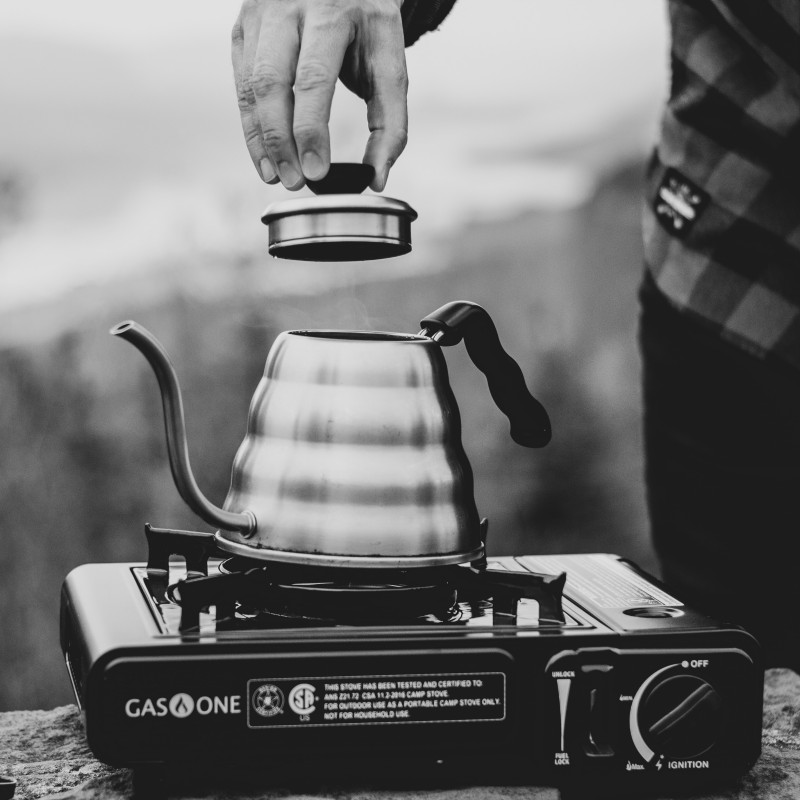
Group Cooking Stoves
Group cooking stoves are essential for larger backpacking trips and expeditions.
Top options include the MSR WindBurner, Jetboil Joule, and Snow Peak GigaPower 2.0. Key features include high BTU output, wind resistance, and stability. Pros include ample cooking space and fast boil times, while cons include higher weight and cost.
Overall, group cooking stoves offer efficient cooking for larger groups in the backcountry.
Review of top group cooking stoves
A group cooking stove can make all the difference when it comes to cooking for larger groups.
These stoves are designed to provide enough cooking space and power to feed larger groups, making them ideal for group camping trips, backpacking with friends or family, and other outdoor activities.
In this section of the post, we’ll look at some of the best group cooking stoves on the market. We’ll examine their key features, advantages and disadvantages, and overall performance so you can make an informed decision about which stove is best for you.
There’s a group cooking stove out there that can help you get the job done whether you’re cooking for a scout troop, a large family, or a group of hungry friends.
Key features, pros and cons, overall performance
We will look at several key features such as size, weight, cooking power, and fuel type when reviewing the best cooking cookers.
We will also consider each cooker’s ease of setup and use, as well as its durability and maintenance.
The advantages and disadvantages will be weighed, with consideration given to factors such as cost, ease of transportation, and overall versatility.
We will thoroughly evaluate each cooker’s performance, including its ability to quickly boil water, cook food evenly, and handle a variety of cooking tasks.
You will gain a better understanding of the top cooking cookers available through our reviews and be able to choose the best one for your specific needs.
Conclusion
When it comes to choosing the right camping stove for your backpacking trip, there are a few important considerations to keep in mind.
First and most importantly, you need to choose a cooker that is reliable, versatile and light in weight. The type of fuel is also a key factor, as it will affect the performance and portability of the cooker.
You should also think about the size and weight of the stove, as well as its features and functions, including ignition, slow fire control, cleaning and maintenance requirements.
Finally, consider the type of cooking you will be doing and the number of people in your group, as this will affect the size and type of cooker you will need.
By carefully weighing up these factors and taking the time to research the different options, you will be able to choose the best camping stove for your next backpacking trip.
When it comes to backpacking and hiking, having a dependable and versatile camp stove can make or break your trip.
You can find a stove that meets your specific needs and preferences by taking into account fuel type, size and weight, features and functionality, and overall performance.
There are plenty of options available, whether you want a single-burner stove for solo trips or a group cooking stove for larger outings.
No matter where your adventures take you, you can enjoy everything from a morning cup of coffee to a hearty meal of chili with the right stove.
When making your choice, consider the key features, pros and cons, and overall performance of each stove to find the best fit for you.
You can enjoy delicious meals and hot drinks on the trail by investing in a high-quality stove, making your backpacking trips more comfortable and enjoyable than ever before.
